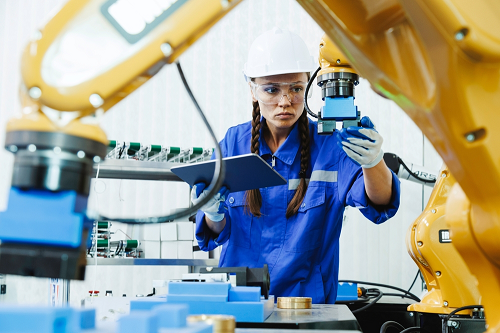Robotics is in a period of rapid growth in industries like manufacturing, warehousing, petrochemical, food processing, and more. This growth has helped improve productivity and workplace safety. Yet as more “collaborative robots” – known as cobots -- interact directly with workers in shared workspaces, higher rates of serious injuries are occurring. These tips can help keep workers safe:

1 Keep employees outside the robot’s work area.
Floor sensors that slow down or stop the robot when an employee gets too close can prevent collisions. Other protections may include guardrails, chain link fencing, or walls; light curtains that stop the robot when an employee interrupts a beam of light around the guarded area; electric safety mats that contain a switch that when stepped on stops the robot; and warning signs and floor tape directing traffic around the robot work zone.
2 Use proper lockout/tagout procedures.
When a robot pins an employee it’s usually during non-routine tasks. All electrical equipment – including robots – store hazardous energy even after being removed from their energy source. Lockout/tagout is a safety procedure to make sure equipment is properly shut off during maintenance or repair work. Make sure all employees who work with robots are trained on lockout/tagout procedures.
3 Interlink the robot’s programming with all safety devices.
Problems occur when operators haven’t linked the robot’s programming to electronic safety devices such as light curtains, shutoff sensors, or door interlocks. Put procedures in place to ensure that all safety devices work together to stop robotic tasks if a sensor is tripped.
4 Create, communicate, and post safety rules in the workplace.
Human error accounts for most accidents in the workplace. Distractions, deadlines, workload, morale, noise levels, and lack of communication can cause errors even among well-trained employees. Regularly communicate and post safety rules in the workplace to remind employees to:- keep all obstructions from the robot work area;
- avoid wearing loose-fitting clothing, ties, and scarves, which can get tangled in the equipment;
- tie up long hair;
- require safety glasses; and
- always remove the tech pendant (the control box for programming the motions of a robot) from the robot’s work area.
5 Provide training and risk assessments.
Training and risk assessments are important to prevent injuries from robotics. Ensure employees know the robot manufacturer’s best practices for safety and maintenance protocols. Also, make sure all employees have safe access to an emergency stop button to shut off power to the robot, and know where the button is located.
For more information, review the American National Standards Institute’s Section R15.06-2012 and the International Organization for Standardization’s robot standards. These include ways to identify risks, design safeguards, test robot safety, and operate robots. Also, review the recently updated chapter in the Occupational Safety and Health Administration’s and the National Institute for Occupational Safety and Health’s technical manual on “Industrial Robot Systems and Industrial Robot System Safety.”
